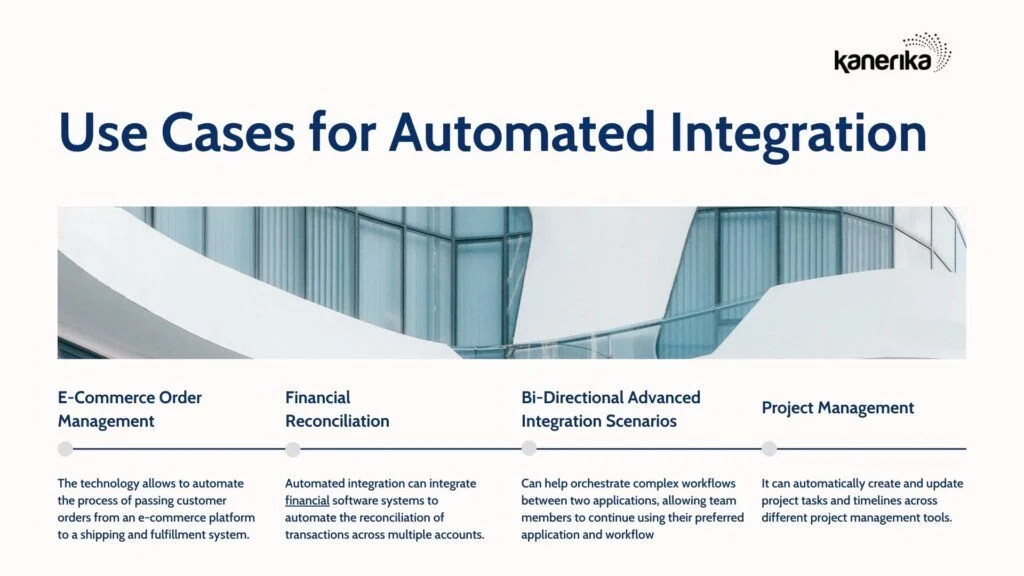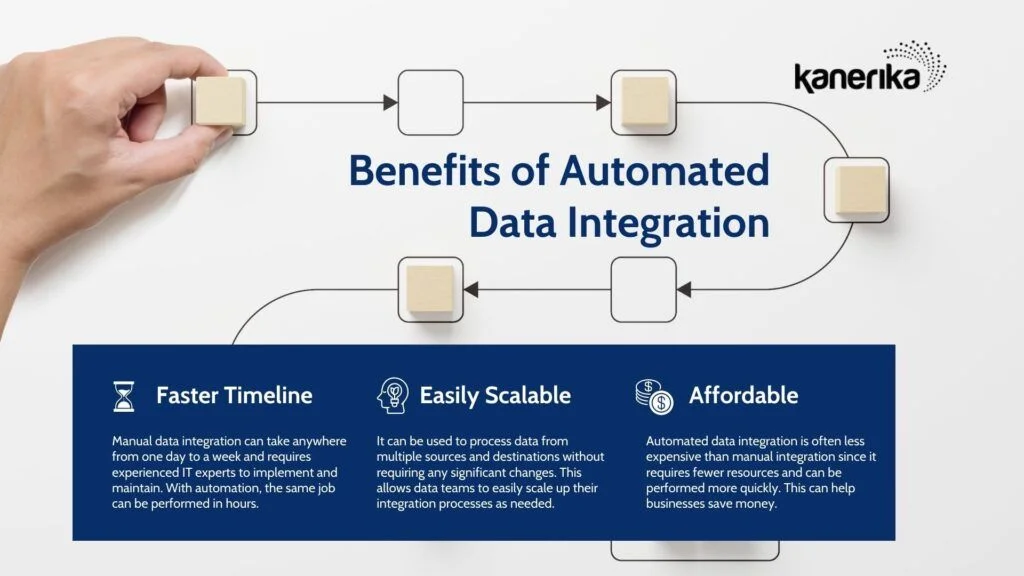McKinsey says data is the most critical asset of any organization, as companies that rely on data to make strategic decisions tend to perform better. However, data is not always reliable or real-time.
Studies indicate that 55% of data is not accessible during decision-making, costing companies an estimated $15 million annually, Meanwhile, data scientists spend 60% of their time cleaning data. Enter – Automated Data Integration.
Data integration allows businesses to combine and leverage disparate data from various sources. This is increasingly important as the amount of data expected to be created over the next few years is set to surpass the data generated over the past 30 years.
Automated integration has become essential in today’s digital landscape, where purpose-built applications such as CRMs, ERPs, proprietary systems, and mobile-based applications are generating vast amounts of data. Organizations are integrating these applications to address challenges posed by inaccessible information and growing software silos.
What is Automated Data Integration?
Data integration is the process of unifying data from various sources into a single dataset for analysis. It has applications in multiple professions, including statistics and finance, and is projected to reach a value of $10.84 billion by 2022, with an 11.6% growth rate between 2021 and 2022.
Nevertheless, as businesses generate vast amounts of data from various software applications, they face the challenge of managing and integrating it effectively.
To address this challenge, businesses adopt integration and collaboration practices to prevent team silos and manage large volumes of data. With the desire to speed up processes and automate daily tasks, organizations often turn to data integration automation.
Data integration automation involves automating integration tasks to run without human intervention, improving efficiency, and reducing IT costs while saving time and resources. This solution allows businesses to accelerate service delivery and enhance customer experience while preventing errors.
Need for Automated Data Integration

As modern businesses demand more advanced integration scenarios, automated integration offers a solution to streamline workflows, connect global networks, and adapt to changing business needs. Here are some common use cases for automated integration:
Read More – Data Ingestion vs Data Integration: How Are They Different?
Bi-Directional Advanced Integration Scenarios
Automated integration tools can help orchestrate complex workflows between two applications. This allows team members to continue using their preferred application and workflow. This can simplify team collaboration, eliminating the need to switch between different systems.
Shorter Time Frames
Automated integration can accelerate the rollout of integrations, reducing the time required from months to days or weeks.
Scalability and Flexibility
Automated integration can enhance the scalability, reliability, and flexibility of integrations to adapt to changing business needs.
Customer Data Integration
Automated integration can automatically import customer data from a website into a CRM system for sales and marketing purposes.
Order Management
The technology allows to automate the process of passing customer orders from an e-commerce platform to a shipping and fulfillment system.
Financial Reconciliation
Automated integration can integrate financial software systems to automate the reconciliation of transactions across multiple accounts.
Project Management
It can automatically create and update project tasks and timelines across different project management tools.
It’s important to note that automated integration solutions can differ based on the specific use case and the technological approach required for each scenario.
Read More – Data Integrity Vs Data Quality: How They Impact Your Business Decisions
How does Automated Data Integration Work?
Automating an integration is a challenging endeavor that requires careful planning and attention to detail for a successful outcome. To achieve this, a systematic approach is necessary. Here’s an outline of the steps involved:
- Start with a clear integration strategy that defines the objectives, scope, and key stakeholders involved.
- Identify the data mappings, transformations, and events that trigger data exchange between the integrated systems.
- Engage all relevant stakeholders early in the process to prevent potential changes or disruptions later in the project.
- Choose an appropriate integration solution that can handle the diverse data types, volumes, and speeds involved in the integration process.
- Implement the integration solution in a modular way, focusing on one component at a time. Conduct a Proof of Concept to validate its feasibility and potential.
- Deploy the integration in the production environment, where it can run automatically and continuously.
- Test the automated integration against various integration scenarios to ensure it performs as expected and meets the required performance standards.
- Maintain the integration solution to ensure it operates smoothly and can adapt to any changes or downtimes in the system.
Given the complexity and dynamic nature of modern integration requirements, manual or outdated approaches like ESB or ETL are no longer feasible. Instead, businesses must adopt modern, flexible, and scalable solutions that can keep up with the evolving IT landscape.
Benefits of Automated Data Integration

Automated data integration has several benefits that can greatly improve the efficiency and effectiveness of BI projects:
Powers Big Data Projects
As the volume of data continues to grow, ETL teams need more time to analyze it and generate insights. Automated data integration tools can process data consistently and quickly, allowing teams to focus more on analysis and less on manual data preparation.
Faster Timeline
Manual data integration can take anywhere from one day to a week and requires experienced IT experts to implement and maintain. With automation, the same job can be performed in hours, freeing up time for ETL teams to focus on more valuable work.
Easily Scalable
Automated data integration is scalable, meaning it can be used to process data from multiple sources and destinations without requiring any significant changes. This allows data teams to easily scale up their integration processes as needed.
Affordable
Automated data integration is often less expensive than manual integration. This is because it requires fewer resources and can be performed more quickly. This can help businesses save money while still achieving their integration goals.
Long-term Solution
Automated data integration allows businesses to focus on long-term forecasts and analysis. It achieves this by easily integrating data from multiple sources into its data warehouse. This can help businesses gain valuable insights into their operations and make more informed decisions.
Automated data integration is critical in managing and integrating vast amounts of data from different software applications. It offers a cost-effective solution to streamline workflows, connect global networks, and adapt to changing business needs. With automated data integration tools, complex workflows between applications can be orchestrated, leading to increased efficiency, scalability, reliability, and flexibility in adapting to changing business needs.
Looking for expert guidance to automate your data integration process? Sign up for a free consultation today!
FAQ
What is automated data integration?
Automated data integration is like having a tireless, super-efficient librarian for your digital data. It automatically gathers information from scattered sources, cleans it up, and organizes it into a usable format. This eliminates manual work and ensures data consistency, saving time and improving decision-making. Think of it as a smart connector for all your digital information silos.
What is an example of automated data?
Automated data is information gathered and processed without direct human intervention. Think of website analytics automatically tracking page views, or a smart thermostat recording temperature changes. It’s essentially data generated by machines, sensors, or software, freeing up humans for other tasks. This contrasts with manually-entered data, like filling out a form.
What is an example of data integration?
Data integration combines data from various sources—like your sales database and customer surveys—into a unified view. Imagine blending different puzzle pieces to create a complete picture of your customer base. This eliminates data silos and provides a more comprehensive understanding of your business. The result is richer, more actionable insights.
What are the types of data integration?
Data integration comes in several flavors, each tackling the problem differently. You’ve got batch processing, ideal for large, infrequent updates; real-time integration for immediate data flow; and ETL (Extract, Transform, Load) which cleans and shapes data before merging. Finally, change data capture focuses on efficiently integrating only the *changes* in data, avoiding redundant processing.
What is an example of integrated automation?
Integrated automation isn’t just one robot doing one job; it’s several systems working together seamlessly. Think of a smart factory where robots, software, and data analytics coordinate to build a product from start to finish, automatically adjusting to changes in demand or supply. This holistic approach streamlines processes and boosts efficiency far beyond what individual automated systems could achieve alone.
What is meant by data integration?
Data integration is the process of combining data from various sources into a unified view. It’s like creating a single, comprehensive puzzle from many scattered pieces, resolving inconsistencies and making the whole picture clearer. This allows for better analysis and decision-making by providing a holistic understanding of your information. Ultimately, it’s about making data more useful and actionable.
What is an example of automatic data processing?
Automatic Data Processing (ADP) means letting computers handle data tasks without constant human intervention. Think of your bank automatically updating your account balance after each transaction; that’s ADP. Payroll systems that calculate wages and issue payments are another prime example. Essentially, it’s automating repetitive data-related work for efficiency and accuracy.
What is the difference between automation and integration?
Automation focuses on making a *single* process or task faster and more efficient, often robotically. Integration, on the other hand, connects *different* systems or processes, allowing them to share data and work together seamlessly. Think of automation as optimizing a single machine, while integration is building a whole factory line. One streamlines a task; the other streamlines a workflow.
What is automated data entry?
Automated data entry uses technology to automatically input data into systems, eliminating manual typing. This speeds up processes dramatically, reducing human error and freeing up employees for more valuable tasks. Think of it as intelligent scanning and conversion – transforming raw data (like invoices or forms) into usable digital information. It’s all about efficiency and accuracy.
What is AI data integration?
AI data integration is the process of combining data from various sources – structured, unstructured, and semi-structured – to create a unified, usable dataset for AI models. It goes beyond simple merging, requiring cleansing, transformation, and harmonization to ensure data quality and consistency crucial for accurate AI insights. Essentially, it’s preparing the raw ingredients for the AI “recipe” to work effectively. This crucial step unlocks the true potential of your data for machine learning.
How to automate the process of integration?
Automating integration streamlines the merging of different systems. This usually involves using tools and APIs to transfer data and commands between systems without manual intervention. Think of it as building a bridge between applications, letting them “talk” to each other automatically and efficiently. This boosts speed, accuracy, and reduces human error.
What is the meaning of automated data processing?
Automated data processing means using computers and software to handle data tasks automatically, eliminating manual intervention. This boosts efficiency by speeding up processes like calculations, sorting, and reporting. Think of it as a robot handling your spreadsheets and databases – faster, more accurately, and consistently. It fundamentally changes how we manage and utilize information.
What is an example of an automated data system?
An automated data system handles information without constant human intervention. Think of a smart thermostat adjusting temperature based on pre-set rules, or an online retailer automatically updating inventory levels after each sale. Essentially, it’s any system that gathers, processes, and acts upon data independently, freeing human operators from repetitive tasks. These systems often involve software, sensors, and networks working together.